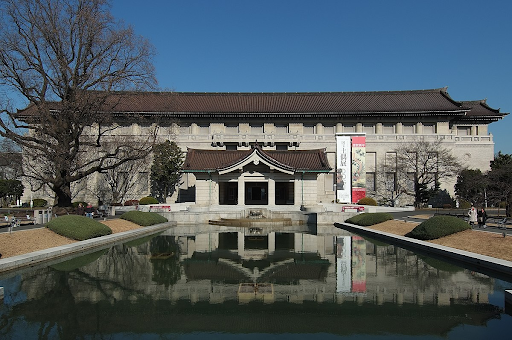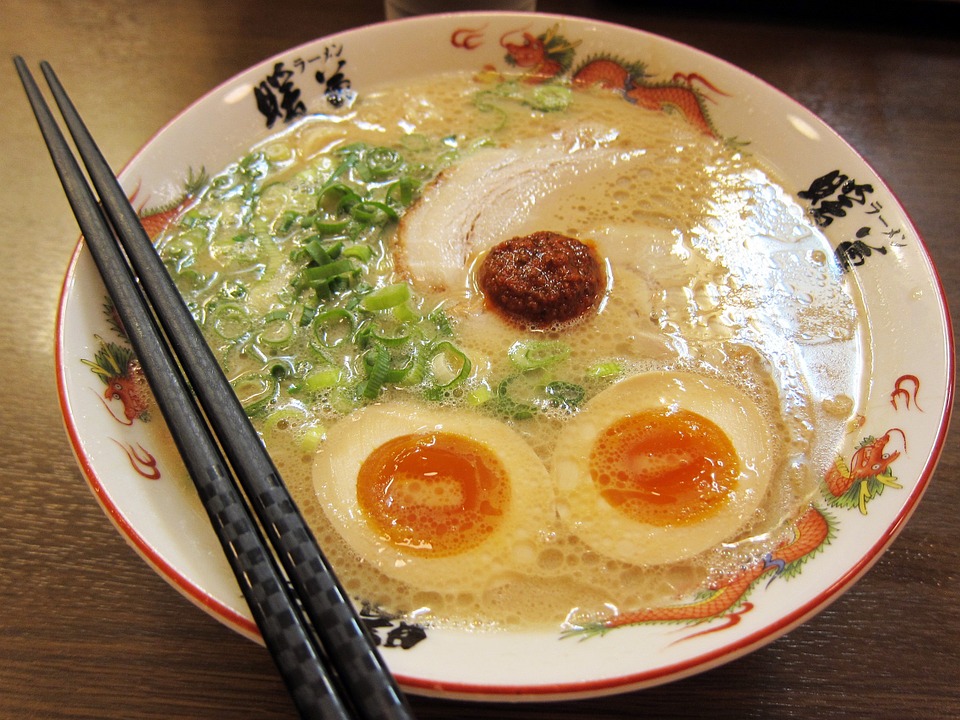Japan is known for its exotic and savory foods. The country lines with France, Italy, Spain for its culinary distinctions and industry - professional standards, unique recipes, blended recipes (Japanese and Western) and food innovation. Japan also ranks in the top 10 countries with the best foods.
Whether you are on vacation or living as an expat, you can find that Japanese foods are not only tasty but also healthy because most Japanese cuisines use low calorie, fresh foods and little processed ingredients.
Main Course
-
Ramen
Photo courtesy of Unsplash and Edward Guk
You have probably heard of Ramen while ordering noodles with broth, seafood and meat pieces or eating a cup of ready to eat noodles. Ramen comprises a potpourri of ingredients - noodles, broth, seasoning and toppings. The noodle is made from wheat flour, water and salt; the broth could be made from a variety of flavours such as chicken, miso (fermented soybean), fish, curry and vegetable.
And the broth that serves as the soup base includes mirin (a type of rice wine with low alcohol content than sake) and soy sauce. You can top Ramen with a variety of ingredients such as eggs, chopped chives, shiitake mushrooms, minced garlic, baby spinach, grated carrots, sprouted mung beans, shredded cabbage.
What makes Ramen interesting is that they can be modified to produce different types. In fact, according to the Japanese Foodie Blog, there are 42 types of Ramen. On top of that, Ramen is easy to make - a quick meal if you’re in a busy lifestyle.
Gyudon (Beef bowl)
Photo courtesy of Unsplash and Rosalind Chang
Gyudon belongs to a donburi (a rice bowl dish) that is a popular daily meal. It is an inexpensive and easy to make meal consisting of sliced onions, chives or onion leaves, sliced beef, sugar, soy sauce and dashi ( a Japanese stock) and mirin. These ingredients are topped on steamed Japanese rice. Gyudon is perfect as a quick and inexpensive meal when you are busy or on budget.
Sushi
Photo courtesy of Unsplash and Bady qb
The ordered arrangement and small servings of cutlets and pieces make Japanese food standout among global cuisine. An example is sushi. This dish originated from the Edo period when pickled fish is preserved in vinegar. Today sushi constitutes these types:
-
Chirashi - A dish made up of sushi rice, mushroom and seafood.
-
Gunkan - Small cups of seafood, sushi rice, dried seaweed wrapper, sea urchin and fish eggs.
-
Inari - A sushi made of deep-fried tofu.
-
Kakuzushi - Popular in Hiroshima, Kakuzushi consist of scrambled egg strips, pickled vinegar, boiled Asari clams and shiitake mushroom on top of boiled rice.
-
Nigiri - A sushi made of numerous types of rice balls topped with eel, octopus, fried egg, fish and shellfish.
-
Norimaki - A roll of seafood and sushi rice wrapped in dried seaweed wrappers.
-
Oshizushi - This sushi is often eaten in train stations as lunch boxes. Oshizushi comprises a stack of layers of pressed egg, lotus root, shrimp and fish flavoured with vinegar.
-
Temaki - Cones made up of seafood, vegetables, sushi rice and nori seaweed.
Tonkatsu
Photo courtesy of Unsplash and Charles PH
Tonkatsu consists of deep-fried and breaded pork and then partnered with shredded cabbage and cherry tomatoes. Tonkatsu is easy to prepare as it only needs a breading and frying pork cutlets. Serve with tonkatsu sauce (a blend of brown sugar, Worcestershire sauce, soy sauce, mirin and garlic cloves).
Dessert
Photo courtesy of Pixabay and la-fontaine
-
Castella (kasutera) or Japanese sponge cake
Although it was brought by Portuguese merchants, Castella is popular in Nagasaki City and often sold in a long rectangular box. Kasutera is often served with whipped cream and coffee during breakfast. Kasutera could be made from mirin, bread flour, honey and sugar and baked for 35 minutes.
-
Matcha parfait
Photo courtesy of flickr and wiennat
Photo courtesy of Pixabay and dungthuyvunguyen
Matcha is a speciality of Kyoto and a blend of Japanese and French influence (1). This dessert consists of matcha (green tea extract) ice cream and a variety of ingredients such as whipped cream, corn flakes, ice cream - all served in a parfait glass.
-
Anko (red bean paste)
-
Cereal
-
Cigarette cookies
-
Cookies
-
Ice cream
-
Kinako (roasted soybean flour)
-
Kuromitsu (dark sugar syrup)
-
Matcha
-
Puffed rice or grains.
-
Shiratama dumplings (a type of small cake)
-
Zunda (sweet bean paste)
Procedures:
Fill a parfait glass with alternating layers of matcha ice cream and other ingredients. Top with puffed rice, cereals and zunda.
Like ramen, parfait can be customized into different flavor combos such as strawberry and choco-banana.
-
Mochi
Mochi’s popularity went beyond Japanese shores as it’s sold in other Asian countries’ groceries or Japanese shops. Mochi is a rice cake akin to Chinese moon cake. It consists of glutinous rice that encapsulates a condiment or some sort of paste or flavouring such as strawberry, chocolate, purple yam and other condiments.
Hundreds of years ago, the Samurai use mochi as a ready to eat or portable food that can keep them nourished before and after the battle. In Shinto religion, mochi is referred to as the food of the gods.
Traditionally, the Japanese make mochi during the ceremony called mochitsuki or Japanese New Year. You can eat mochi as a dessert or as an ingredient for Matcha parfait.
Appetizer
-
Tempura
Photo courtesy of Pixabay and cegoh
Tempura consists of seafood or vegetable that has been battered and deep-fried into a crisp. Commonly, the Japanese use shrimp or Ebi (えび) or other meat bases such as crab claws and legs; squid, kisu or whitefish, anago or saltwater eel, sea urchin roe and hotate or scallops. Vegetable tempura may include mushrooms, carrot, eggplant, okra, bell pepper, bamboo shoots and other ingredients.
Tempura is eaten with a dipping sauce made from various flavor notes - umami, salty, sour and sweet.
Tempura ingredients:
Tempura batter:
2 egg yolks
1 cup of ice cold water
1 cup of rice flour
1 cup of shrimps (deveined with tails and shells removed)
1 pinch of baking soda
Dipping sauce:
½ cup of sake or mirin
1 tsp sugar
1 tsp grated ginger
1 tbsp sesame oil
¼ grated radish
1 tsp sugar
Procedure:
-
For the batter, mix the ingredients until it becomes fluffy and light. Don’t overbeat.
-
Coat the shrimps.
-
Deep fry the shrimps until golden brown.
-
Serve with a dipping sauce and garnish with chilli slices.
Korokke (Croquette)
Photo courtesy of Wikimedia Commons
Korokke refers to a ball of minced meat, egg, onion, vegetables and spices and then rolled in a flour and breadcrumb coating. The coated balls are then deep fried until brown and crunchy. Add a side vegetable such as parsley and tonkatsu for dipping sauce.
Sashimi
Photo courtesy of Flickr and Jeremy Keith
Sashimi is a delicacy made up of small portions or cutlets of raw tuna, salmon, molluscs, shellfish, fish eggs and uni or sea urchin roe. This dish is served with soy sauce and wasabi (Japanese horseradish). Sashimi comes with different varieties depending on the meat cutlets.
Salad
-
Okura no Aemono
Photo courtesy of Flickr and Rovingl
Okra, a vegetable with white pods inside and slimy texture, is the main ingredient of this salad. Okra is easy to make as it consists of only a handful of ingredients such as the following:
-
Sea salt
-
1 tbs of soy sauce
-
10 to 15 pieces of Okra (sliced into small pieces)
-
1pack of sesame seeds
-
1 cup Daishi
-
1 small saucer of bonito flakes (fermented and dried skipjack tuna)
To prepare, you have to mix okra pieces and season with soy sauce, Daishi and garnish with sesame seeds.
-
Daikon radish salad
Photo courtesy of Flickr and Flickr upload bot
Daikon radish is a mild flavoured winter radish often used in Japan in pickles (bettarazuke, takuan), stir-fries and salads. The Japanese eat the leaves of Kaikon radish during the Nanakusa-nosekku festival or the custom of eating the leaves of wild springs on spring. To make this salad, you have to gather ingredients such as the diakon radish, crab meat or an alternative - imitation crab meat, strips of nori seaweed, and bonito flakes. Prepare the ponzu dressing that is made from mayonnaise, ponzu (a Japanese condiment) and ground white sesame seeds. Mix the solid ingredients and pour with ponzu sauce.
Exotic foods
-
Goya
Photo courtesy of Flickr and sfllaw
You may have already heard of bitter melon, then goya is a stir-fried bitter melon slice cooked with egg, soy sauce and pork. This dish is popular among Okinawans (inhabitants of Okinawa Islands) as they have survived against fatigue during the subtropical season. Some people won’t try bitter melon because of its bitter taste coupled with crunchy and watery texture but this vegetable is a popular ingredient because of it’s laden with nutrients.
-
Green caviar (Umi Budou)
Photo courtesy of Wikimedia Commons
Caviar, a common food in expensive restaurants, is basically made with salted sturgeon fish eggs. But green caviar is different, it’s a seaweed type that features a cluster of green spheres - nicknamed as sea grapes. The Japanese eat sea grapes as an ingredient in salads. Its taste is slightly salty with a slimy texture that bursts when eaten. Seagrapes are nutritious that contains iodine, omega 3, Vitamins A, B, C and antioxidants.
-
Dancing squid
Photo courtesy of Pixabay and Umiyuki
If you like to try the freshest of all seafoods, then here is the dancing squid. A Japanese chef will catch a live squid for you. He prepares by opening its mantle (outer flesh or skin) and removes it from the rest of the mantle cavity and organs. Then he chops the tentacles and prepares it with another ingredient such as vegetables. When a soy sauce or salt is applied, lifeless tentacles move because of the energy stored in the muscle. The squid is served with vegetable leaf and fish eggs.
The Japanese use the same technological ingenuity to their food. They make it presentable, nutritious and easy to prepare. If you are planning to live in Japan for short or long term stays, you’ll appreciate its culture by trying the country’s cuisine.
Reference:






